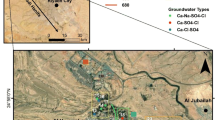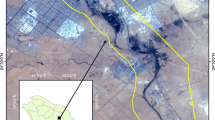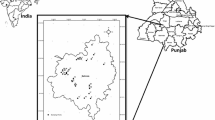Abstract
Elemental compositions of water, and surface and subsurface soils indicate characterization and mobilization of elements within soil profiles. The chemical variations of groundwater (n = 21) and surface and subsurface soils (n = 18 each) of the Polpithigama area were examined to determine elemental spatial variation in the area. Physico-chemical parameters (pH, electrical conductivity (EC), dissolved oxygen (DO), oxygen reduction potential (ORP)) and NO3−, PO42−, Mn, Fe, and F were analyzed for the water samples in the field using field test kits. Soil samples were analyzed using X-ray fluorescence for 22 major and trace elements. Iron, Mn, NO3−, and PO42− concentrations in water are lower than the threshold values of WHO. The fluoride content was increased with high elevation even within a short distance. The fluoride and phosphate are highly variable between the soil layers and are preferably retained in the surface soil. The vertical variation is resulted by intensive weathering under tropical conditions, mobility of ions, variation of elements, and variation of soil constituents such as different contents of organic matter and clay content consisting of high total sulfur (TS) contents. Migration of some ions to the groundwaters of the area is possible due to high mobility of elements and thus the compositions of some elements show variations in the surface and subsurface soils.









Similar content being viewed by others
Availability of Data and Material
All data and materials of the research are available and can be obtained on request.
Code Availability
Not applicable.
References
Appelo, C.A.J., Postma, D. (1993). Geochemistry, groundwater and pollution, A.A. Balkema, Netherlands, pp 536.
Brindha, K. & Elango, L. (2011). Fluoride in groundwater: Causes, implications and mitigation measures. In: Monroy, S.D. (Ed.), Fluoride properties. Applications and Environmental Management, pp. 111–136.
Chandrajith, R., Padmasiri, J. P., Dissanayake, C. B., & Prematilaka, K. M. (2012). Spatial distribution of fluoride in groundwater of Sri Lanka. Journal of National Science Foundation Sri Lanka, 40(4), 303–309.
Dharmagunawardhana, H.A. (2004). Fluoride in groundwater surface water rocks and soils of an area of endemic fluorosis: In the dry zone of Sri Lanka. In: 4th international workshop on fluorosis prevention and defluoridation of water. Inter country Center for Oral Health, Colombo, Sri Lanka.
Dharmagunawardhane, H. A., & Dissanayake, C. B. (1993). Fluoride problems in Sri Lanka. Environmental Management and Health, 4(2), 9–16.
Dissanayake, C. B., & Chandrajith, R. (2019). Fluoride and hardness in groundwater of tropical regions - review of recent evidence indicating tissue calcification and calcium phosphate nanoparticle formation in kidney tubules. Ceylon Journal of Science, 48(3), 197–207.
Dissanayake, C. B., Chandrajith, R., & Tobschall, H. J. (2000). The geology, mineralogy and rare element geochemistry of the gem deposits of Sri Lanka. Bulletin of the Geological Society of Finland. https://doi.org/10.17741/bgsf/72.1-2.001
Dissanayake, C. B. (1991). The fluoride problem in the ground water of Sri Lanka — environmental management and health. International Journal of Environmental Studies, 38(2–3), 137–155. https://doi.org/10.1080/00207239108710658
Ekanayake, L., & Van der Hoek, W. (2002). Dental caries and developmental defects of enamel in relation to fluoride levels in drinking water in an arid area of Sri Lanka. Caries Research, 36(6), 398–404.
Gago, C., Romar, A., Fernández-Marcos, M. L., & Álvarez, E. (2014). Fluoride sorption and desorption on soils located in the surroundings of an aluminium smelter in Galicia (NW Spain). Environmental Earth Sciences, 72, 4105–4114.
Gandhi, N., Sirisha, D., Smita, A., & Manjusha, A. (2012). Adsorption studies of fluoride on Multani Matti and Red Soil. Research Journal of Chemical Sciences, 2(10), 32–37.
Illeperuma, O. A. (2000). Environmental pollution in Sri Lanka: A review. Journal of National Science Foundation of Sri Lanka, 28(4), 301–325.
Jayawardana, D.T., Pitawala, H.M.T.G.A., & Ishiga, H. (2010). Groundwater quality in different climatic zones of Sri Lanka: Focus on the occurrence of fluoride, International Journal of Environmental Science and Development, 1(3), ISSN: 2010–0264.
Zhu, L., Zhang, H. H., Xia, B., & Xu, D. R. (2007). Total fluoride in Guangdong soil profiles, China: Spatial distribution and vertical variation. Environment International, 33(3), 302–308.
Majkić-dursun, B., Petković, A., & Dimkić, M. (2014). The effect of iron oxidation in the groundwater of the alluvial aquifer of the Velika Morava River Serbia, on the Clogging of Water Supply Wells. Journal of the Serbian Chemical Society, 80(7), 947–957.
Takeno, N. (2005). Atlas of Eh – pH diagrams. Geological Society of Japan Open File Report, 419, 11–183.
Pradhan, R.M., & Biswal, T.K. (2018). Fluoride in groundwater: A case study in Precambrian terranes of Ambaji region, North Gujarat, India, PIAHS, Proc. IAHS, 379, 351–356.
Reid, M. K., & Spencer, K. L. (2009). Use of principal components analysis (PCA) on estuarine sediment datasets: The effect of data pre-treatment. Environmental Pollution, 157, 2275–2281.
Latha, S. S., Ambika, S. R., & Prasad, S. J. (2011). Fluoride contamination status of groundwater in Karanataka. Current Science, 76(6), 730–734.
Rizzu, M., Tanda, A., Cappai, C., Roggero, P. P., & Seddaiu, G. (2021). Impacts of soil and water fluoride contamination on the safety and productivity of food and feed crops: A systematic review. Science of the Total Environment, 787, 15. https://doi.org/10.1016/j.scitotenv.2021.147650
Sairam Sundaram, C., Viswanathan, N., & Meenakshi, S. (2008a). Defluoridation chemistry of synthetic hydroxyapatite at nano scale: Equilibrium and kinetic studies. Journal of Hazardous Materials, 155(1–2), 206–215.
Sairam Sundaram, C., Viswanathan, N., & Meenakshi, S. (2008b). Uptake of fluoride by nano-hydroxyapatite/chitosan, a bioinorganic composite. Bioresource Technology, 99(17), 8226–8230.
Saxena, V. K., & Ahmed, S. (2001). Dissolution of fluoride in groundwater a water-rock interaction study. Environmental Geology, 40, 1084–1087.
Senanayake, N., Perera, M.T.M.D.R., & Weragoda, A. (2005). Acid rains and rains causing acidity of soils in Sri Lanka, Proceedings of the Third International Symposium on Air Quality Management at Urban, Regional and Global Scales, Istanbul – Turkey. pp. 28–35.
Silva, E. I. L., & Manuweera, L. (2004). Surface and rainwater chemistry in Sri Lanka A risk of acidification. Asian Journal of Water, Environment and Pollution, 1(1–2), 79–86.
Subasinghe, H. C. S., Ratnayake, A. S., & Sameera, K. A. G. (2021). State-of-the-art and perspectives in the heavy mineral industry of Sri Lanka. Mineral Economics. https://doi.org/10.1007/s13563-021-00274-3
Tang, C., Azuma, K., Iwami, Y., Ohji, B., & Sakura, Y. (2004). Nitrate behaviour in the groundwater of a headwater wetland Chiba, Japan. Hydrological Process, 18, 3159–3168.
Tennakoon, T.M.M.H. (2004). Dental fluorosis in Anuradhapura District, Sri Lanka, 4th International Workshop on Fluorosis Prevention and Defluoridation of Water.
Wambu, E.W., & Kurui, A.J. (2018). Fluoride adsorption onto soil adsorbents: The role of pH and other solution parameters, Chapter 3, https://doi.org/10.5772/intechopen.74652.
Wimalawansa, S. J. (2016). The role of ions, heavy metals, fluoride, and agrochemicals: Critical evaluation of potential aetiological factors of chronic kidney disease of multifactorial origin (CKDmfo/CKDu) and recommendations for its eradication. Environmental Geochemistry and Health, 38, 639–678.
Woods, A. M., Lloyd, J. M., Zong, Y., & Brodie, C. R. (2012). Spatial mapping of Pearl River Estuary surface sediment geochemistry: Influence of data analysis on environmental interpretation. Estuarine, Coastal and Shelf Science, 115, 218–233.
Zhao, Z., Zhao, J., & Zong., Y. (2009). Experiment study of fluoride desorption with groundwater infiltration in soil, IEEE, https://doi.org/10.1109/ICBBE.2009.5162811
Acknowledgements
Funding from the Japanese government to carry out the research is highly appreciated. The government offices in Polpithigama area who supported the sampling are acknowledged.
Funding
Funding is received from the Japanese government to carry out the research.
Author information
Authors and Affiliations
Contributions
The first author was involved in the sampling, sample preparation for analysis, data analysis, and writing of the manuscript.
The second author was involved in sampling, analysis, and supervising.
Corresponding author
Ethics declarations
Conflict of Interest
The authors declare no competing interests.
Ethics Approval
Not applicable.
Consent to Participate
Not applicable.
Consent for Publication
Both authors and the funding agency and the university where the analysis was done have the consent for publication and have no objections.
Additional information
Publisher's Note
Springer Nature remains neutral with regard to jurisdictional claims in published maps and institutional affiliations.
Rights and permissions
About this article
Cite this article
Young, S.M., Ishiga, H. Characteristics of Groundwater and Soil Chemical Variation of Polpithigama Area, Sri Lanka. Water Air Soil Pollut 232, 328 (2021). https://doi.org/10.1007/s11270-021-05287-w
Received:
Accepted:
Published:
DOI: https://doi.org/10.1007/s11270-021-05287-w




